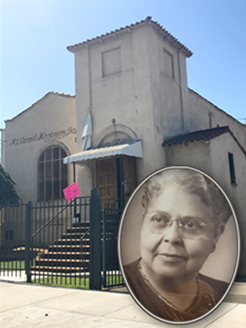African Americans in Boyle Heights: An Untold Legacy
 |
| Mt. Carmel Baptist Church, a Boyle Heights legacy. Inset: Minnie J. Jackson. Photo courtesy of Pamela Davis/Andy Takajian and the Lawrence Family Archives. |
In the neighborhood, the schools, the cemetery, the churches, the workplace, the political movements… we were everywhere, especially if and when being there meant being a part of building and sustaining this vibrant multi-cultural enclave.
Our organization seeks to develop a historical perspective documenting the early arrivals and the continuous influx of our elders into an enclave well known for its significant place within the history of Los Angeles. Less familiar are the contributions our elders made to Boyle Heights from its earliest days onward.
As members of “Boyle Heights - African Americans Were There,” an organization we are pleased to introduce within the pages of Brooklyn & Boyle, we work to present the facts surrounding our existence. We work to restore our history. And just as importantly, we work to educate the public regarding who the Black people were; what their lives were like; their inclusion within and contributions to the neighborhood in which they lived, the occupations they pursued, and the dreams they had for themselves and for their children.
The Lawrence Family
Both hailing from the culturally diverse community of Boyle Heights, William Henry Lawrence, an African American teenager, and Palma Katz, a child of Jewish immigrants and eldest of their two daughters, met at Roosevelt High School. They married in 1940.
Their ceremony was a product of the times; interracial marriages were illegal in California, so they went to Mexico, where backward racist views on intermarriage were not codified into law. With little knowledge of the Spanish language, in later years they shared with their children how they weren’t sure they were truly married until Palma received, for their three children, family allotment checks from the government while her husband, Bill, served two years in the segregated United States Navy, seeing combat in Okinawa. .
Bill’s parents, William Peck Lawrence and Minnie Jeanise Jackson, came to Boyle Heights in 1906, and, as was the case for most Blacks in the community, Mt. Carmel Baptist Church was at the center of their activities and their lives outside the home. Born in 1888 in Texarkana, Texas, Minnie was a staunch member of the congregation. Her husband William Peck Lawrence, called “Red,” was born in Missouri.
They met in Oklahoma and came to Boyle Heights and married when they were 17 years-old. Red worked for the Boyle Manufacturing Company which made galvanized tubs, garbage cans and other “Boyco” steel products. Soon after starting this job, company founder Willis J. Boyle (no relation to Boyle Heights pioneer Andrew Boyle) hired Red to work at his home as chauffeur and gardener, where Red was employed for 44 years.
Red and Minnie built a home on Malabar Street for their family of four children. The home, with its Spanish design, stood out amongst the traditional wood-framed houses in the neighborhood and was known for its uniqueness and was admired by neighbors. It became known as “The Lawrence Place.”
Of their four children, Bill became a fireman in 1946 after coming home from the Navy. Like all African American firefighters who were in the city beginning in 1892, he served in racially segregated stations in South Los Angeles.
Joanne, the eldest of Bill’s three children, says it was always clear to her that her Dad would never leave the Heights. The diversity, she says, along with the comfort and safety of Malabar St. were of utmost importance to him.
After the grandparents, Red and Minnie, died, Bill, Palma and their three children; Joanne, Billy and Ron moved into “The Lawrence Place,” from the housing project for returning WWII veterans located in Griffith Park, where they had lived following the war.
Before the war, Bill and Palma, and their children, lived on Malabar in the rear of the Malabar stucco home. All of the children attended Malabar St. School as did their father. Two of Red and Minnie’s children passed away. Their one daughter, Ida Mae, helped to set the family tradition, like her brother Bill, by graduating from Malabar Elementary, Belvedere Middle School and Roosevelt High.
Shirlee Smith, born and raised in Boyle Heights, attended First Street Elementary, Stevenson Jr. High and Roosevelt High School, graduating as proud Rough Rider in the summer of 1954.
Her opinion columns appeared in the Pasadena Star News for over 40-years. And she won a First Place award for “Personal Commentary” from the Los Angeles Press Club as a result.
Her best-selling book, They’re Your Kids, Not Your Friends, is now also available in a Spanish-language edition titled Son Tus Hijos, No Tus Amigos. For her continuous work as a community activist, she received the KCET/Union Bank Local Hero Award. Brooklyn & Boyle is extremely proud to welcome the venerable Ms. Smith as our newest contributing writer. Reach her at talkaboutparenting@gmail.com and let her know that you appreciate her voice, her wisdom and her work to ensure that the story of Black Boyle Heights, one that continues to this day, is acknowledged and honored.




Comments
Post a Comment